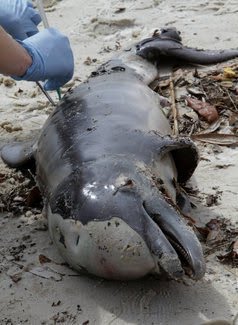BP's Gulf of Mexico PR, One Year Later
 BP logo wiltingFinger-pointing over the Deepwater Horizon disaster resumed recently after the U.S. Department of the Interior and the Coast Guard issued a joint report (pdf) which concluded all three corporate participants in the calamity -- BP, Transocean Ltd. and Halliburton -- were at fault. The report concluded all three companies violated federal laws and safety regulations by "failing to take necessary precautions to keep the Macondo well under control at all times." The report also found all three companies were "jointly and severally liable for the failure to comply with all applicable regulations." That means all three companies are mutually responsible for the accident, and each can be held singly responsible for the entire debacle. The report parsed blame among the companies for sloppy materials and workmanship, inadequate training, failure to properly assess risk and conduct proper testing, failure to abide by stop-work work policies after multiple anomalies were discovered, and so on.
BP logo wiltingFinger-pointing over the Deepwater Horizon disaster resumed recently after the U.S. Department of the Interior and the Coast Guard issued a joint report (pdf) which concluded all three corporate participants in the calamity -- BP, Transocean Ltd. and Halliburton -- were at fault. The report concluded all three companies violated federal laws and safety regulations by "failing to take necessary precautions to keep the Macondo well under control at all times." The report also found all three companies were "jointly and severally liable for the failure to comply with all applicable regulations." That means all three companies are mutually responsible for the accident, and each can be held singly responsible for the entire debacle. The report parsed blame among the companies for sloppy materials and workmanship, inadequate training, failure to properly assess risk and conduct proper testing, failure to abide by stop-work work policies after multiple anomalies were discovered, and so on.
The Blame-Go-Round
Despite the report citing all three companies as equally liable, Transocean now believes it has been vindicated. Brian Kennedy, a Transocean company spokesman, said "The report...finally puts to rest all previous allegations that improper maintenance of the [blowout preventer] contributed to the tragedy." He characterized the explosion on the Deepwater Horizon as "unavoidable."
 Dead baby dolphins are turning up along the Gulf coast in high numbers (2011)Halliburton still denies virtually any responsibility for the debacle. In response to the government's report, Halliburton fired back that its workers were not involved in making critical decisions, and issued the following statement: "Every contributing cause where Halliburton is named, the operational responsibility lies solely with BP."
Dead baby dolphins are turning up along the Gulf coast in high numbers (2011)Halliburton still denies virtually any responsibility for the debacle. In response to the government's report, Halliburton fired back that its workers were not involved in making critical decisions, and issued the following statement: "Every contributing cause where Halliburton is named, the operational responsibility lies solely with BP."
BP agreed with the report's "core conclusion" that the accident was the result of "multiple causes, involving multiple parties, including Transocean and Halliburton." BP encouraged the other companies to "acknowledge their roles in the accident" and urged them to make changes to prevent similar accidents in the future. The report, though, held BP "ultimately responsible for conducting operations at Macondo in a way that ensured the safety and protection of personnel, equipment, natural resources and the environment."
Strangely, BP's stock jumped 5 percent after the government issued the report.
BP Fakes Contrition While Fighting Regulation
One year after the blowout in the Gulf of Mexico, BP is still putting on a game PR face, publicly trying to look like it accepts responsibility for the disaster. Behind the scenes, though, the company is quietly engaging in activities that cast doubt on its sincerity and appearance of contrition. For example, BP is one of the highest-level corporate funders of the American Legislative Exchange Council (ALEC), a corporate bill mill that gives companies a hand in crafting business-friendly legislation and resolutions. ALEC helps energy companies fight restrictions on offshore drilling and pushes a deregulatory agenda at every turn. BP forked over $100,000 to be a "Presidential" level funder of ALEC's August 2011 annual meeting in New Orleans, more than Chevron, Exxon Mobil, ConocoPhillips or even Koch Industries paid to support the meeting. ALEC is also a powerful promoter of global warming denial, sponsoring anti-environmental legislation and working to portray the U.S. Environmental Protection Agency (EPA) as an "out of control" "train wreck" after the agency started moving towards regulating greenhouse gas emissions.
Between February and May, 2011 -- after 13 states suddenly passed similar-sounding resolutions urging Congress to block EPA's effort to regulate greenhouse gases -- the Center for Media and Democracy traced this mysterious outbreak to ALEC. The "model resolution" (pdf) was crafted an approved by an ALEC committee that is co-chaired by a gas industry trade group.
Contrary to What BP Wants the Public to Believe, All is Not Well in the Gulf
 PR photo of Gulf beachgoers from BP's websiteThe PR tactics seem to fit BP's strategic "corporate responsibility" needs at this point. But while BP's website shows pleasing photos of clean sea turtles and throngs of happy beachgoers cavorting in the water along the Gulf of Mexico seashore, reports about the status of the Gulf one year later show marshes still saturated with oil, even after billions of dollars have been spent on cleaning. One marsh that BP pronounced particularly clean showed oil oozing out of the mud just below the water's surface when journalists stepped in it, and it still reeked. Louisiana wildlife officials say animals continue to be affected by marsh oil, and believe thousands of birds have died in the deep brush, where rangers can't see them. BP has also refused to help restore Louisiana's oyster beds, saying "BP is not obligated to pay for such damage -- because it was not caused by the oil spill." The damage, BP claims, was caused by a release of fresh water, but the fresh water was only released because of the oil disaster, to try and flush out the wetlands. Dolphins and dead endangered sea turtles are washing up on Gulf shorelines at 10 to 20 times the normal numbers. Boston.com, the website of the Boston Globe, has an array of amazing before-and-after photos of the Gulf, and photos of Gulf residents still suffering from the effects of the tragedy.
PR photo of Gulf beachgoers from BP's websiteThe PR tactics seem to fit BP's strategic "corporate responsibility" needs at this point. But while BP's website shows pleasing photos of clean sea turtles and throngs of happy beachgoers cavorting in the water along the Gulf of Mexico seashore, reports about the status of the Gulf one year later show marshes still saturated with oil, even after billions of dollars have been spent on cleaning. One marsh that BP pronounced particularly clean showed oil oozing out of the mud just below the water's surface when journalists stepped in it, and it still reeked. Louisiana wildlife officials say animals continue to be affected by marsh oil, and believe thousands of birds have died in the deep brush, where rangers can't see them. BP has also refused to help restore Louisiana's oyster beds, saying "BP is not obligated to pay for such damage -- because it was not caused by the oil spill." The damage, BP claims, was caused by a release of fresh water, but the fresh water was only released because of the oil disaster, to try and flush out the wetlands. Dolphins and dead endangered sea turtles are washing up on Gulf shorelines at 10 to 20 times the normal numbers. Boston.com, the website of the Boston Globe, has an array of amazing before-and-after photos of the Gulf, and photos of Gulf residents still suffering from the effects of the tragedy.
BP is hoping that Americans will simply forget about the 2010 Gulf disaster, absorb their corporate PR strategies unquestioningly, and won't look any deeper than the "all's fine" facade they're striving to spin.




